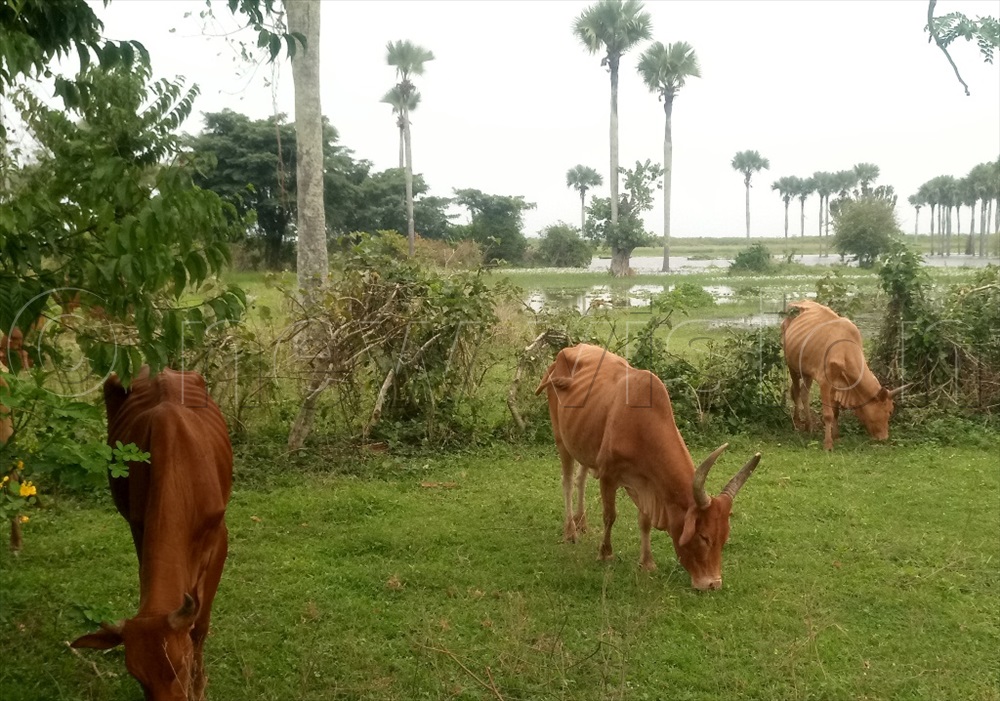By Tom Gwebayanga
For the second time in Buyende district’s history, the rising water levels of River Nile and Lake Kyoga have submerged the three vital cattle-lick sites, namely, Mungugo, Kiguuli in Kagulu sub-county, and Kapyokolo near Bukungu landing site where the River Nile meets Lake Kyoga.
The two-square kilometre Mungugo site, renowned for its salty soil where herds gathered to lick the mineral and for mass mating all year round, is now submerged.
This calamity poses a significant threat to the livestock industry, affecting pasture availability and increasing treatment costs for waterborne diseases.
Heavy rains over the past three months have caused water bodies, including Lake Kyoga, to overflow. The Mungugo site not only offered salty soil for livestock health but also ample pastureland.
Bulls and cows from Budiope East county and beyond were herded here for mating, with charges ranging from sh10,000 to sh20,000.
Peter Madooba, the Nkoone LC2 chairperson, describes Mungugo as a livestock tourism hub where different cattle species meet for mating, attracting spectators and even bullfights.
Stephen Malagala, the Irundu LC3 chairperson, explains that farmers traditionally left their livestock at Mungugo for four to six months, returning to collect mothers and calves.

Robert Samanya, theBupyoko LC1 chairperson, laments the loss, noting the overwhelming impact of the current flooding compared to previous years.
Dr James Wakabi, the Kagulu sub-county agriculture extension and veterinary officer, emphasises the nutritional value of Mungugo’s soil, which naturally provides essential nutrients, eliminating the need for processed cattle salt known as kisula.
The Mungugo site submersion has already led to disease outbreaks among livestock due to nutrient deficiencies, causing widespread concern and economic setbacks in the livestock farming community.
The interruption of mating activities, crucial for breeding, is at risk of becoming a historical event until water levels recede, a process expected to take two to three years or longer if at all.
Other sites submerged
The Buyende district environment officer, Rebecca Namuddu, said the calamity at Mungugo resulted from climate change-induced torrential rains that inundated the nation and caused water bodies, including Lake Kyoga, to overflow.
The flooding also submerged Kiguuli, another salty grazing site in Kagulu, and Kapyokolo, near Bukungu landing site in the greater Buyanja sub-county.
Emma Segujja Kabenge, an advisor of the BukunguFishing and Marketing Society Ltd, expressed concerns over the absence of natural salt, which has led to widespread health issues among the herds.
As a result, large-scale farmers have relocated their herds to safer sites on the mainland, contributing to congestion alongside locals’ food crop farms.
“There’s a severe shortage of pasture. Even the papyrus reeds, which could have served as an alternative grass source, have been submerged,” Anthony Mbalumya Tagaya, the district councillor for Irundu sub-county, said.
Over 450 families displaced
In addition to the devastation at Mungugo, councillor Tagaya, reports that over 450 families in Nkoone parish have been affected by the floods, with homes submerged or collapsed across the 11 local councils.
This calamity has displaced nearly 1,200 locals, who are now seeking refuge in the homes of relatives and rental accommodations in nearby trading centres such as Bukyala, Bupyoko, Namalogwe and Kibugo.
“Churches and mosques are also providing shelter to many affected individuals and the number continues to rise,” Tagaya said during a guided tour with New Vision on Thursday last week.
Cattle crushes destroyed
The submersion of the Mungugo site has had significant repercussions beyond agricultural losses. The crushes, where mass spraying for ticks and mites used to occur, are now underwater.
This has disappointed veterinary professionals, specialists and students who regularly conducted research, fieldwork and disease investigations at the site.
“These professionals would talk with farmers, providing insights on farm management, disease prevention and other related matters,” Wakabi said, citing an increase in livestock health issues since the site’s submersion.
The prolonged flooding has also raised concerns among locals about the presence of crocodiles and snakes in the flooded areas.
John Muwadi, the Buyende district fisheries officer, highlighted incidents of crocodiles entering homesteads and attacking individuals, including fishermen and women drawing water.
“Such incidents have been reported as the waters continue to encroach,” Muwadi said, underscoring the ongoing risks faced by the affected communities.
What farmers said
Jaliru Tyama, Budipa landing site
The floods have disrupted business at the site, where we used to strike deals to market our cattle as well as accessing high-quality bulls to mate with our cows.
Lusiya Adeke, Bupyoko, Nkoone
Mungugo was a radiating centre, besides being a safe haven for livestock. Some people would leave their cattle in Mungugo to mate, only come back to seek updates on the progress of gestation and picking the cows and the birthed calves.
Constantino Baatala, 75, Bupioko village
I was born and bred here, but I had never seen Mungugo submerged. I doubt that the water levels will reduce and allow us to use the site. This has added to the existent challenges of our homes collapsing and losing our crops to the floods.





